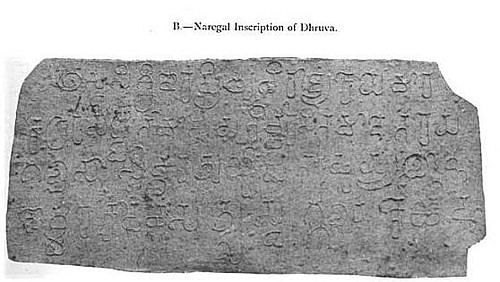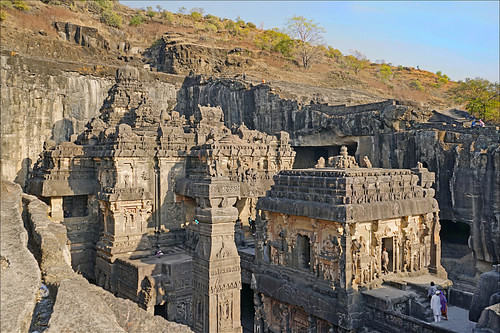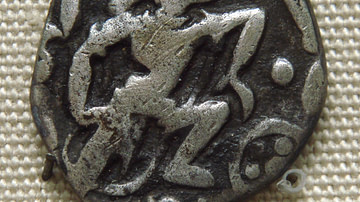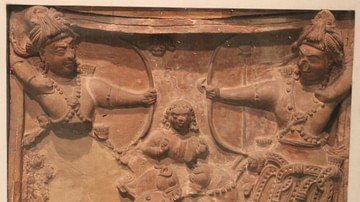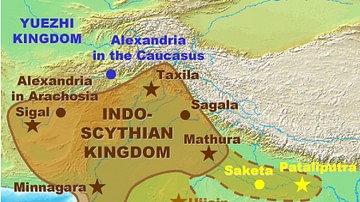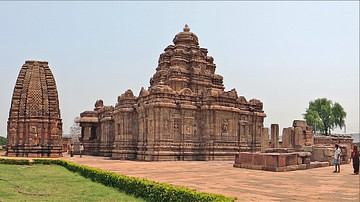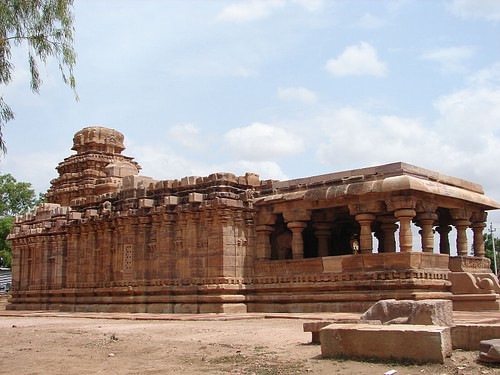
The Rashtrakuta Dynasty ruled parts of South India from the 8th to the 10th century CE. At its zenith, their kingdom included the modern state of Karnataka in its entirety along with parts of the current Indian states of Tamil Nadu, Andhra Pradesh, Telangana, Maharashtra and Gujarat. Their importance can be gauged from the writings of many Islamic travellers and scholars, especially Al-Masudi and Ibn Khordadbih (10th century CE), who wrote that all the other kings of India at that time prayed to the Rashtrakutas as a higher power and prostrated themselves in reverence before them, such was their influence and impression.
Origin & Rise to Power
The name 'Rashtrakuta' in Sanskrit means 'Country' (Rashtra) and 'Chieftain' (Kuta). This explains their lineage from the time of the Mauryan Emperor Ashoka the Great (3rd century BCE) when they were primarily small clan heads in different parts of India. In some of the edicts of Ashoka (in Mansera, Girnar, Dhavali) the word Rathika appears, who may have been the ancestors of the Rashtrakutas. However, though many historians claim that the Rashtrakutas were the earlier Rathikas mentioned in those inscriptions, this theory is not backed up by enough archaeological evidence. Medieval Sanskrit literature reveals fragments of their lineage, which is thought to be from the Mauryan times as small clan heads.
However, their rise began when Dantidurga (also knows as Dantivarman, r. until 756 CE), who was a feudatory of the Badami Chalukyas, defeated their King Kirtivarman II in 753 CE. Dantidurga's ascent started from the time when he helped the Chalukyas in their successful war against the incoming Arab army (between 731 and 739 CE). Soon, it became apparent that he was not satisfied in being just a vassal state and started exerting his influence through military aggression. He defeated the kings of Kosala and Kalinga, subdued the Gurjaras of Malwa, defeated other kings of Central India, and made friendship with the Pallava king Nandivarman II Pallavamalla of Kanchi by giving his daughter in marriage, before he made the final assault on the Chalukya king in 753 CE and thus established the Rashtrakuta Empire.
Expansion
Dantidurga died without a male heir and was succeeded by his uncle Krishna I (r. c. 756 - 773/774 CE). Krishna I gave the final death nail to their erstwhile masters, the Badami Chalukyas, when he routed them in 757 CE to end that dynasty's rule. He expanded his kingdom by invading the Ganga territory and defeating them, by subjugating the Konkan territories and sending his own son to the Eastern Chalukya kingdom of Vengi and accepting their submission without a fight. Krishna I is also culturally very important in the history of India because he was the man behind the construction of the exquisite Kailasa Temple of Ellora (a UNESCO World Heritage site now).
Krishna I was succeeded by his eldest son Govinda II (r. c. 774-780 CE). Govinda II's military adventures include his journey to the Eastern Chalukya kingdom upon instruction of his father and also helping a certain Ganga king in securing the throne from his brother. How he came to his end in life is not known but he was overthrown by his younger brother Dhruva Dharavarsha.
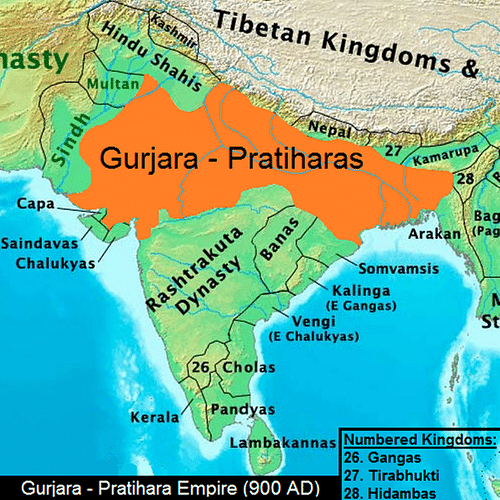
The ascension of Dhruva Dharavarsha (r. 780-793 CE) marks the golden period of the Rashtrakutas. He started his military conquests, first of all, by punishing all the kings who were friendly to his elder brother, and then venturing into the imperial Kannauj and defeating its king. Dhruva then defeated the Gurjara-Pratihara Kingdom of Central India and the Pala Kingdom of Eastern India which was centred around present-day Bengal, and thus with him started the tripartite struggle between the Gurjara-Pratihara Empire, the Rashtrakutas, and the Pala Dynasty to control the main heartland of India. The battle for Kannauj (located in modern-day Uttar Pradesh state) is one of the most important events in the medieval history of India. His other victories include subjugating the Vengi king who could only ensure peace by offering his own daughter in marriage to Dhruva Dharavarsha. He had also successfully moved against the Pallavas of Kanchi (present-day Tamil Nadu) and their immediate neighbours, the Western Ganga Dynasty.
Govinda III (r. 793-814 CE) succeeded his father Dhruva, and though he came to power through a family feud, soon proved to be militarily the most powerful emperor of this dynasty. Though Dhruva had successfully moved into North India in his time, he had not gained many lands. Govinda III rectified that by expanding his kingdom from Kannauj to the Cape Comorin (Kanyakumari now) and from the east of India from Banaras, Bengal etc. to the west of India mainly to the Gujarat territories, and thus on his way defeating numerous kings and rulers like the Gurjara-Pratihara king Nagabhata II, King Dharmapala of the Pala Empire, Pallava Dantivarman, Cholas, Pandyas, Vishnuvardhana IV of Vengi, and several others. Even the King of Ceylon (current-day Sri Lanka) admitted his own subjugation and continued as a feudatory of the Rashtrakutas by paying time to time tributes to them.
Next in line was the greatest of all the Rashtrakuta kings, Govinda III's son, Amoghavarsha I, also called Nripatunga (c. 814-878 CE). He ascended the throne at a very early age due to the death of his father in 814 CE but could not hold real power as an emperor until 821 CE. He was a scholar king under whom the art, literature, and culture of the kingdom flourished. He himself endorsed and wrote landmark pieces in both the Kannada and Sanskrit languages. He also made Manyakheta (Malkhed in Karnataka now) the centre of the empire by which they are known today as the Rashtrakutas of Manyakheta.
Amoghavarsha I ruled for almost 64 years, and though he faced many wars and battles, by temperament he was a peace-loving ruler. He preferred friendly relations with his feudatories over war and used marriages and other amiable gestures to secure their loyalty. Being a lover of art and scholarship, scientists prospered under his rule and his kingdom was adorned with beautiful and intricate artworks and architecture all around. He also equally patronised Buddhism, Jainism, and Hinduism, but many scholars are of the opinion that personally he probably followed Jainism.
After Amoghavarsha I came various rulers (like Krishna II, Indra III, Amoghavarsha II, Govinda IV, Amoghavarsha III, Krishna III, Khottiga Amoghavarsha, Karka II, and Indra IV) with mixed successes. One of the notable successes was that of King Indra III (r. 915-928 CE), who captured Kannauj in the early 10th century (c. 916 CE). Inscriptions in temples in Tamil Nadu and its surroundings reveal that King Krishna III (r. 939-967 CE) invaded the Chola territory and defeated the Chola army decisively in the 10th century CE.
Government, Administration, & Military
The Rashtrakutas divided their kingdom into various provinces, and the provinces were further divided into districts. The kings or emperors of the Rashtrakutas were followed in hierarchy by a Chief Minister who had a cabinet of ministers and different army personnel under him. All the ministers had to undergo military training and be ready for war at any moment. The empire had a mighty army who were always kept ready, especially in their capital city for any incursion or invasion. It was divided into three units; infantry, cavalry, and elephants. It was always diligently trained and kept in proper shape all the time. Feudatory kingdoms would pay tributes, and in case of a special warlike situation or a natural calamity, the administration would also exact some special taxes to meet the expenses, but not at the cost of the happiness and well-being of its subjects. However, the precarious balance that the Rashtrakutas had to maintain between war and well-being, between defence and invasion, between expansion and their administration, ultimately led to their decline.
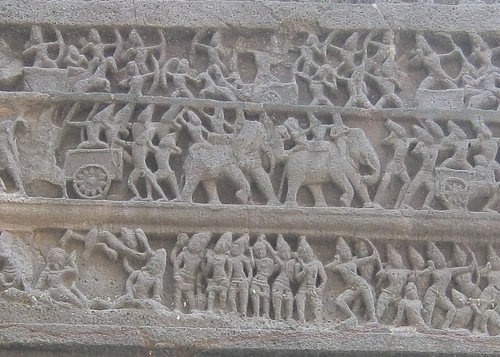
Society
The subjects of the Rashtrakuta Empire looked up to their emperor or king as the ultimate authority who was expected to look after them and uphold the current social justice, order, and peace. However, for day-to-day matters, there were guilds or co-operatives who would decide on any disputes as per the prevalent custom, and if the case could not be solved, then it was brought to the notice of a higher authority. These guilds generally followed the prevailing rules and regulations of a particular group or caste and would deviate only under special circumstances.
The society was divided into various castes based on profession. The prevailing castes had their own sets of rules, regulations, and customs, which they followed quite diligently. They also followed ancient orthodoxy. However, due to the Rashtrakuta rulers being tolerant towards all religions, society was generally accommodative of adherents of various faiths.
Trade, Commerce, & Economy
The South Indian and the Deccan region was not as fertile as the Ganges valley, but the Malabar coast and other areas still yielded enough agricultural produce to take care of the food supplies. Further, due to the incursion and expansion of the empire to Kannauj and other central and North Indian plains, the food supplies augmented from time to time. As the Kannada states were rich in mineral resources and the coastal areas were controlled by the Rashtrakutas, the export of Indian silk and cotton to Arabia, Persia, and other countries was unlimited. Jewellery and ivory were other important products of the empire while import included Arabian horses. Rulers issued gold and silver coins.
Religion & Language
Kannada is one of the most important languages in current-day India, and it was the Rashtrakutas who made it popular and a tool of day-to-day communication, though the language had already been in use for a long time. They also patronised Sanskrit which was actually a language of the elite. Amoghavarsha I was instrumental in composing groundbreaking works in both languages, and his Kavirajamarga was an important milestone in Kannada poetry. His work in Sanskrit became widely acclaimed and was read in other Asian countries as well. Amoghavrasha I was said to have endorsed Jainism and so a lot of Jain scholars flourished in his court, including the. Jain mathematician Mahavirachariya. In Kannada, Adikabi Pampa and Sri Ponna flourished and are now considered to be iconic contributors to the language.
Art & Architecture
The Rashtrakutas were instrumental in establishing an aesthetic architectural form now known as the Karnata Dravida style. The stunning Kailasa Temple of Ellora (a rock-cut structure) is the epitome of Rashtrakuta architectural achievement, but many of the caves of Ellora and Elephanta (in present-day Maharashtra state) have also been created and renovated under the supervision of the Rashtrakutas. Another UNESCO World Heritage Site, the temples at Pattadakal also came under the sway of the Rashtrakutas after the defeat of the Chalukyas and were subsequently renovated and expanded by the Rashtrakutas. The Jain Narayana Temple is said to be solely created by the Rashtrakuta Dynasty.
Decline & Legacy
The decline of the Rashtrakutas began from the reign of Khottiga Amoghavarsha who was defeated and killed by a Paramara dynasty ruler in 972 CE, with the capital Manyakheta plundered and destroyed, thus putting a severe dent to the prestige of the dynasty. The last ruler of the kingdom, Indra IV took his own life in 982 CE by performing a Jaina ritual called Sallekhana, which is a practice of fasting to death.
The Rashtrakuta Dynasty came to an end, but their impact remained. The parts of their kingdom were annexed by the later Cholas and other dynasties, but their system of government and several other cultural practices were also followed by the subsequent empires. Culturally, the temples at Pattadakal or the Ellora structures, and numerous medieval literary works bear testimony to the fine tastes of the Rashtrakutas and their patronage.
